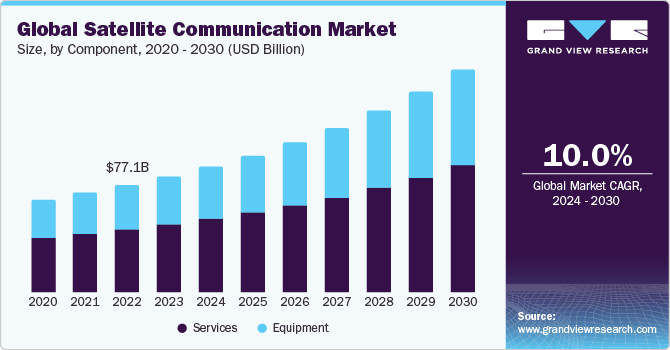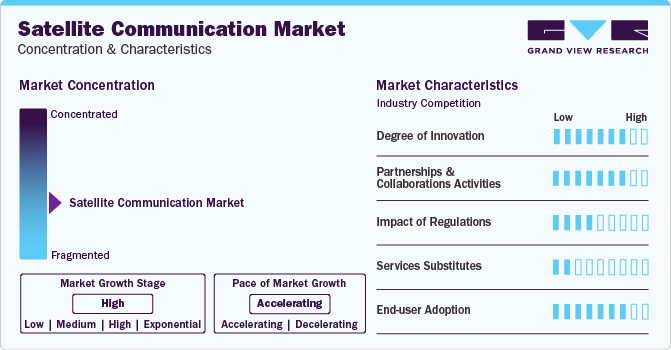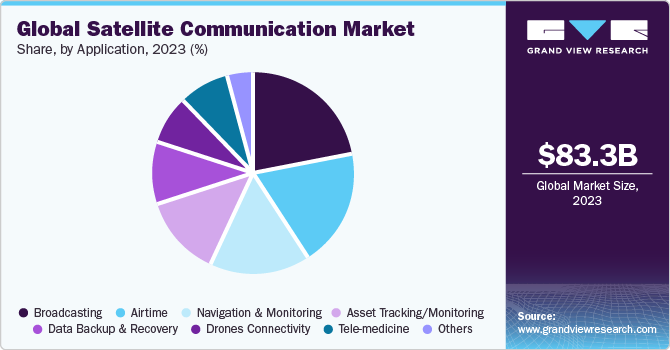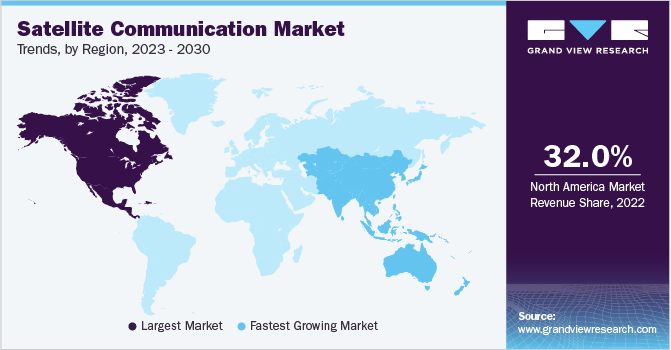- Home
- »
- Communications Infrastructure
- »
-
Satellite Communication Market Size & Share Report, 2030GVR Report cover
![Satellite Communication Market Size, Share & Trends Report]()
Satellite Communication Market Size, Share & Trends Analysis Report By Component, By Satellite Constellations, By Frequency Band, By Application, By Vertical, By Region, And Segment Forecasts, 2024 - 2030
- Report ID: GVR-4-68038-975-3
- Number of Report Pages: 150
- Format: PDF, Horizon Databook
- Historical Range: 2017 - 2023
- Forecast Period: 2024 - 2030
- Industry: Technology
Satellite Communication Market Trends
The global satellite communication market size was estimated at USD 83.29 billion in 2023 and is expected to grow at a CAGR of 10.0% from 2024 to 2030. The promising growth prospects of the market can be attributed to the growing demand for High-throughput Satellite (HTS) systems, which provide significantly increased capacity and data speeds compared to traditional systems. HTS systems enable faster and more efficient data transmission, making them ideal for bandwidth-intensive applications such as video streaming, remote sensing, and Internet of Things (IoT) connectivity.

New frequency bands, such as high-frequency and very high-frequency bands, are also rapidly expanding the available satcom spectrum. These bands offer improved bandwidth and increased capacity, enabling higher data rates and supporting bandwidth-intensive applications. Several solution providers across the globe are focusing on developing solutions that offer better connectivity for a myriad of use cases. For instance, in June 2023, Get SAT Ltd, a provider of miniaturized Satcom terminals, launched its latest product line, MoComm.
The line of multi-orbit communication solutions features the innovative multi-orbit communication capability. This feature enables smooth and efficient switching between satellite constellations, ensuring uninterrupted connectivity. MoComm operates seamlessly in both Ku and Ka-bands. The Ka-band functionality empowers users to seamlessly transfer data traffic between the O3b Medium Earth Orbit (MEO) constellation and any Geostationary Orbit (GEO) constellation. The Ku-band has received certification for compatibility with Low Earth Orbit (LEO) and any GEO constellation, further expanding its versatility and applicability.
Increasing use of Satcom in government and defense sectors is contributing to the growing demand for HTS capacity. Government agencies are increasingly relying on sensor data and ISR platforms to transform their operational environments. These platforms facilitate the sharing of real-time HD video and other valuable information obtained from Remotely Piloted Air Systems (RPAS) or Unmanned Aerial Vehicles (UAVs). In response to this growing demand, leading industry players such as Viasat, Inc. and SES S.A. are making significant investments aimed at pioneering novel solutions tailored to various government and defense applications.
The growing deployment of satellite constellations dedicated to IoT connectivity is also contributing to industry growth. These constellations consist of several small satellites working together to provide global coverage for IoT devices, enabling seamless communication and data exchange across vast geographic areas. This trend is driven by the applications of IoT technology in areas such as agriculture, logistics, environmental monitoring, and asset tracking, where uninterrupted connectivity is essential.
Another emerging trend is the development of LEO satellite networks specifically designed for IoT applications. LEO satellites offer advantages such as lower latency, improved signal strength, and higher data throughput, making them well-suited for IoT data transmission. These networks leverage advanced technologies such as narrowband and low-power communication protocols to optimize IoT device connectivity, ensuring efficient utilization of satellite resources.
Furthermore, the satellite communication market is witnessing the adoption of advanced technologies such as Artificial Intelligence (AI), which are driving the emergence of Intelligent Transport Systems (ITS). These systems enable real-time vehicle tracking, facilitating the swift exchange of information for both users and freight operators. SATCOM integration in transportation ensures continuous and seamless data transmission between vehicles and transport hubs, reducing the reliance on terrestrial networks.
Market Concentration & Characteristics
The industry is witnessing a high growth stage and an accelerating pace of growth. The Satcom industry is characterized by a high degree of innovation with a rapidly evolving technology landscape. One of the latest industry trends is the growing demand for smaller and more compact subsystems to replace large satellites. The industry is also characterized by a high level of collaborations, partnerships, and service launches by leading industry players to develop and offer satellite connectivity services to diverse industries.

Satcom services have no direct substitutes as they play a critical role in ensuring seamless connectivity in remote locations where wired and wireless communication do not reach. End-use industries, including media & broadcasting, government & defense, maritime, and energy and utility, utilize these services to improve their productivity and the efficiency of business activities. However, regulatory trends significantly influence the growth of the industry. For instance, the Communications Act requires the issuance of a license for any commercial communications transmitted through satellite to, from, and within the U.S.
Component Insights
The services segment dominated the market in 2023 and accounted for a 59.04% share of the global revenue. The segment growth can be attributed to the global expansion of the media and entertainment industries, coupled with the increasing demand for satellite television in emerging nations. Efforts to enable seamless data transmission to end-user locations also favor the increased demand for Satcom services across the globe.
However, the high upfront costs associated with satellite acquisition often make it financially challenging for many firms to invest in the technology outright. As a result, an increasing number of companies are opting for satellite services through leasing arrangements. Domestic Direct-to-Home (DTH) operators, for instance, are typically limited to using satellites ordered by their respective space agencies or leasing capacity from foreign satellites. Technological advancements play a crucial role in reducing manufacturing costs, thereby lowering lease expenditure, and driving revenue growth of the market.
The equipment segment is likely to expand at a promising pace over the forecast period, thanks to the growing need for uninterrupted communication across industries and increasing use of connected and autonomous vehicles. Satcom equipment ensures the smooth functioning of diverse applications, such as telecommunications, navigation, weather monitoring, and surveillance systems, by enabling effective communication with satellites orbiting the Earth. The introduction of LEO satellites and satellite constellations for telecommunication purposes is also expected to drive the equipment segment growth.
Vertical Insights
The media & broadcasting segment dominated the market in 2023. The media & broadcasting industry is one of the leading consumers of satellite communication technology. Media and broadcasting businesses leverage the technology to transmit live news, satellite television and radio, sports events, concerts, and various other programs to their audience. Moreover, satellites are used to broadcast video channels that can be received by both broadcast networks and cable operators, benefitting consumers globally.
The government & defense segment is projected to grow at the highest CAGR over the forecast period. Increasing emphasis on secure and resilient satcom solutions to meet the evolving needs of government agencies and defense organizations is a key factor contributing to the growth of the segment. This includes the adoption of advanced encryption techniques, anti-jamming capabilities, and robust cybersecurity measures to safeguard sensitive data and ensure uninterrupted communication in critical situations.
The growing demand for satellite-based Intelligence, Surveillance, and Reconnaissance (ISR) capabilities is also driving segment growth. Government and defense entities are leveraging satellite communication to gather real-time information, monitor remote areas, and enhance situational awareness. The integration of high-resolution imaging, video streaming, and advanced analytics technologies is enabling more effective ISR operations, facilitating rapid decision-making and response.
Application Insights
The broadcasting segment dominated the market in 2023. The segment growth can be attributed to the growing demand for satellite communications in pay-TV and radio applications. DTH providers use satcom to deliver services to customers and ensure seamless connectivity, even in remote and inaccessible areas. Growing consumer expectations for high-quality audio and video content have driven significant advancements in Satcom equipment.
For instance, the emergence of IP live-production technology has facilitated the production and transmission of Ultra-High Definition (UHD) and 4K content, significantly enhancing the consumer’s viewing experience. Furthermore, investments in the broadcasting and cable television industries, coupled with technological advancements and government incentives in emerging economies aimed at the transition to digital platforms, are significant factors contributing to the segment's growth.

The airtime segment is projected to witness significant growth over the forecast period, chiefly owing to the rising demand for reliable and affordable communication services for flights and aircraft. Satcom solutions offer seamless connectivity and high-speed internet access onboard aircraft, catering to the needs of both the crew and business applications. The growing use of satcom for aircraft navigation and remote troubleshooting is also expected to contribute to the segment's promising growth prospects.
Regional Insights
The North America regional market dominated in 2023 and accounted for a revenue share of 45.25%. Growing demand for satellite broadband services, especially for providing reliable connectivity in remote, hard-to-reach, and underserved regions of North America, is likely to drive regional growth over the forecast period. The region is also home to key industry players such as Viasat, Inc.; Intelsat; Telesat; and Harris Technologies, Inc. Their strong focus on innovations and investments in research and development, advanced technologies, and strategic partnerships are fueling the expansion of the industry in the region.

U.S. Satellite Communication Market Trends
The U.S. market is expected to expand at a CAGR of 9.3% from 2024 to 2030. The market is characterized by strategic partnerships and initiatives, such as supportive student connectivity and distance learning programs powered by satellite internet, which contribute to market expansion.
The satellite communication market in Canada is expected to expand at a notable CAGR of 11.4% from 2024 to 2030. The emphasis on broadband connectivity projects and collaborations with global providers highlight growth opportunities for the SATCOM market in the country, particularly in connecting remote regions.
Europe Satellite Communication Market Trends
The Europe market is expected to register a CAGR of 10.3% from 2024 to 2030. The regional market is witnessing a shift toward self-reliance and sustainability. Ambitious proposals for establishing satellite constellations and substantial funding plans reflect a strategic focus on enhancing market capabilities and reducing dependency on foreign entities.
The satellite communication market in the UK is expected to exhibit a CAGR of 11.4% from 2024 to 2030. Investments in research and development, coupled with collaborations with international partners, are driving innovation and fostering the SATCOM industry growth in the UK
The satellite communication market in Germany is expected to expand at a CAGR of 10.5% from 2024 to 2030. Germany's satcom market is marked by efforts to integrate space technology into various sectors, including digital transformation and industry.
Asia Pacific Satellite Communication Market Trends
The Asia Pacific regional market is projected to register the highest CAGR over the forecast period. This can be attributed to the relentless pursuit of innovation, research and development, and strategic initiatives by prominent market players aimed at enhancing their market presence. Growing reliance on satcom-dependent services in sectors such as telecommunications, media and broadcasting, agriculture, and energy and utility is also a notable driver of market growth. Moreover, the region is home to numerous organizations dedicated to advancing satellite communications.
The satellite communication market in China is expected to expand at a CAGR of 11.7% from 2024 to 2030. The China market is characterized by rapid expansion, driven by aggressive satellite deployment and advanced technology adoption. Focus on military and defense applications, along with significant investments in satellite infrastructure, solidifies China's position as a key player in the global market.
The satellite communication market in India is expected to register a CAGR of 9.2% from 2024 to 2030. Increasing demand for satellite internet services and partnerships with space agencies are contributing to the industry growth in India.
The satellite communication market in Japan is expected to register a CAGR of 11.3% from 2024 to 2030. The Japan market is evolving with the entry of new players and technological advancements.
MEA Satellite Communication Market Trends
The MEA market is expected to exhibit a CAGR of 8.0% over the forecast period. Focus on broadband connectivity projects, coupled with increasing demand from the military and defense sectors, is creating significant growth opportunities for SATCOM services and solutions in the MEA market.
The satellite communication market in the Kingdom of Saudi Arabia (KSA) is expected to expand at a promising pace over the forecast period. The KSA market is driven by strategic investments in advanced technologies, aimed at bolstering economic diversification and technological innovation.
Key Satellite Communication Company Insights
Some of the key companies operating in the market are Viasat, Inc., SES S.A, L3 Harris Technologies, Inc., EchoStar Corporation, and SKY Perfect JSAT Group.
-
Viasat, Inc. is engaged in providing communications technologies and services. The company offers end-to-end platforms for ground infrastructure, Ka-band satellites, and user terminals to provide high-speed, high-quality broadband solutions to enterprises, governments, and consumers across the globe.
-
EchoStar Corporation provides satcom solutions. The company’s geographic presence spans various countries, including the U.S., Brazil, Germany, Italy, Mexico, Russia, the UAE, and the U.K.
Intelsat S.A., Telesat Corporation, Thuraya Telecommunications Company (Yashat), Gilat Satellite Networks Ltd., and Cobham Limited, are some of the emerging companies in the satcom market.
-
Thuraya Telecommunications Company is a UAE-based provider of mobile satellite services. The company offers advanced communications solutions to various sectors, including energy, broadcast media, military, marine, and aerospace.
-
Intelsat S.A. offers satcom services for transmitting data, video, and voice signals. The company provides these services to various media companies, wireless & fixed telecom operators, data networking service providers, ISPs, and multinational corporations.
Key Satellite Communication Companies:
The following are the leading companies in the satellite communication market. These companies collectively hold the largest market share and dictate industry trends.
- Viasat, Inc.
- SES S.A
- Intelsat S.A.
- Telesat Corporation
- EchoStar Corporation
- L3Harris Technologies, Inc
- Thuraya Telecommunications Company (Yashat)
- SKY Perfect JSAT Holdings Inc.
- Gilat Satellite Networks Ltd.
- Cobham Limited
Recent Developments
-
In April 2023, SES S.A. and Corporación Nacional de Telecomunicaciones (CNT), a telecommunications provider, partnered to support Ecuador's digital inclusion efforts in the Galapagos Islands. They have announced a significant expansion agreement for medium earth orbit satellite capacity. This expansion aims to provide enhanced broadband connectivity and 3G/4G/5G mobile services to businesses, residents, and tourists across the isolated Galapagos Islands in the eastern Pacific Ocean, contributing to the development and connectivity of the region.
-
In April 2023, Gilat Satellite Networks Ltd. announced that was expanding its strategic collaboration with Intelsat S.A. to expand Intelsat S.A.’s capabilities in cellular backhaul and In-Flight Connectivity (IFC). This expansion includes multimillion-dollar orders for Gilat Satellite Networks Ltd.’s multi-service platforms and terminals.
-
In March 2023, Thuraya Telecommunications Company introduced the Tactical Radio Extender over Satellite (T-TAC), targeting enterprise and government markets. T-TAC is designed to provide enhanced satcom capabilities in tactical environments to enable reliable and secure communication.
Satellite Communication Market Report Scope
Report Attribute
Details
Market size value in 2024
USD 90.30 billion
Revenue forecast in 2030
USD 159.60 billion
Growth rate
CAGR of 10.0% from 2024 to 2030
Actual data
2017 - 2023
Forecast period
2024 - 2030
Report updated
May 2024
Quantitative units
Revenue in USD million/billion and CAGR from 2024 to 2030
Report coverage
Revenue forecast, company market share, competitive landscape, growth factors, and trends
Segments covered
Component, satellite constellations, frequency band, application, vertical, region
Regional scope
North America; Europe; Asia Pacific; Latin America; and Middle East & Africa (MEA)
Country scope
U.S.; Canada; UK; Germany; France; Italy; China; India; Japan; South Korea; Brazil; Mexico; Kingdom of Saudi Arabia; UAE; South Africa
Key companies profiled
Viasat, Inc.; SES S.A; Intelsat S.A.; Telesat Corporation; EchoStar Corporation; L3Harris Technologies, Inc; Thuraya Telecommunications Company; SKY Perfect JSAT Holdings Inc.; Gilat Satellite Networks Ltd.; Cobham Limited
Customization scope
Free report customization (equivalent up to 8 analysts working days) with purchase. Addition or alteration to country, regional & segment scope002E
Pricing and purchase options
Avail customized purchase options to meet your exact research needs. Explore purchase options
Global Satellite Communication Market Report Segmentation
This report forecasts revenue growth at regional and country levels and provides an analysis of the latest industry trends and opportunities in each of the sub-segments from 2017 to 2030. For the purpose of this study, Grand View Research has segmented the global satellite communication market report based on component, satellite constellations, frequency band, application, vertical, and region:
-
Component Outlook (Revenue, USD Million, 2017 - 2030)
-
Equipment
-
Satcom Transmitter/Transponder
-
Satcom Antenna
-
Satcom Transceiver
-
Satcom Receiver
-
Satcom Receive
-
Satcom Modem/Router
-
Others (Block-up converters, controllers)
-
-
Services
-
-
Satellite Constellations Outlook (Revenue, USD Million, 2017 - 2030)
-
Low Earth Orbit (LEO) Satellites
-
Medium Earth Orbit (MEO) Satellites
-
Geostationary Equatorial Orbit (GEO) Satellites
-
-
Frequency Band Outlook (Revenue, USD Million, 2017 - 2030)
-
L-band
-
S-band
-
C-band
-
X-band
-
Ku-band
-
Ka-band
-
-
Application Outlook (Revenue, USD Million, 2017 - 2030)
-
Asset Tracking/Monitoring
-
Airtime
-
M2M
-
Voice
-
Data
-
-
Drones Connectivity
-
Data Backup and Recovery
-
Navigation and Monitoring
-
Tele-medicine
-
Broadcasting
-
Others
-
-
Vertical Outlook (Revenue, USD Million, 2017 - 2030)
-
Energy & Utility
-
Government & Defense
-
Government (Civil Uses)
-
Emergency Responders
-
Defense
-
-
Transport & Cargo
-
Fleet Management
-
Rail services
-
-
Maritime
-
Mining and Oil & Gas
-
Oil & Gas
-
Mining
-
-
Agriculture
-
Communication Companies
-
Corporates/Enterprises
-
Media & Broadcasting
-
Events
-
Aviation
-
Environmental & Monitoring
-
Forestry
-
End User - Consumer
-
Healthcare
-
Others
-
-
Regional Outlook (Revenue, USD Million, 2017 - 2030)
-
North America
-
U.S.
-
Canada
-
-
Europe
-
UK
-
Germany
-
France
-
Italy
-
-
Asia Pacific
-
China
-
India
-
Japan
-
South Korea
-
-
Latin America
-
Brazil
-
Mexico
-
-
MEA
-
Kingdom of Saudi Arabia
-
UAE
-
South Africa
-
-
Frequently Asked Questions About This Report
b. The global satellite communication market size was estimated at USD 83.29 billion in 2023 and is expected to reach USD 90.30 billion in 2024.
b. The global satellite communication market is expected to grow at a compound annual growth rate of 10.0% from 2024 to 2030 to reach USD 159.60 billion by 2030.
b. North America dominated the market for satellite communication and accounted for a 32.18% share in 2023.
b. Some key players operating in the SATCOM market include SES S.A.; Viasat, Inc.; Intelsat; Telesat; EchoStar Corporation; L3 Technologies, Inc.; Thuraya Telecommunications Company; SKY Perfect JSAT Group; GILAT SATELLITE NETWORKS; Cobham Limited.
b. Key factors that are driving the satellite communication market growth include the escalating demand for small satellites for earth observation services in various industries such as oil & gas, energy, agriculture, and defense and the increasing use of satellite communications by companies to collect operational data to improve efficiency and to realize sustainable ways of conducting business.
Share this report with your colleague or friend.
![gvr icn]()
NEED A CUSTOM REPORT?
We can customize every report - free of charge - including purchasing stand-alone sections or country-level reports, as well as offer affordable discounts for start-ups & universities. Contact us now
![Certified Icon]()
We are GDPR and CCPA compliant! Your transaction & personal information is safe and secure. For more details, please read our privacy policy.
We are committed towards customer satisfaction, and quality service.
"The quality of research they have done for us has been excellent."





